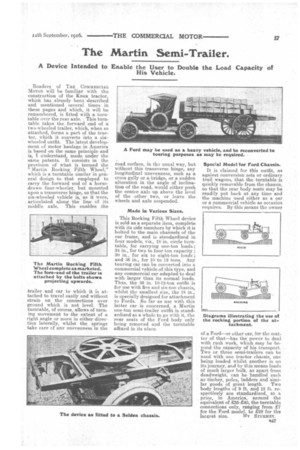The Martin Semi-Trailer.
Page 17

If you've noticed an error in this article please click here to report it so we can fix it.
A Device Intended to Enable the User to Double the Load Capacity of
His Vehicle.
Readers of THE COMMERCIAL MOTOR will be familiar with the construction of the 'Knox tractor, which has, already been described and mentioned several times in these pages and which, it will be remembered, is fitted with a turntable over the rear axle. This turntable takes the forward end of a two-wheeled trailer, which, when so attached, forms a. part of the tractor, which it converts into a sixwheeled outfit. The latest development of motor haulage in America is based on the same principle and is, I understand, made under the same patents. It consists in the provision of what is termed the "Martin Rocking Fifth Wheel," which is a turntable similar in general design to that employed to carry the forward end of a horsedrawn four-wheeler, but mounted upon a transverse hinge, so that the six-wheeled vehicle is, as it were, articulated along the line of its middle axle. This enables the
trailer and car to which it is attached to travel easily and without strain on the connections over ground which is not level. The turntable, of course, allows of turning movement to the extent of a right angle or more in either direction laterally, whilst the springs take care of any unevenness in the road surface, in tin usual way, but without this transverse hinge, any longitudinal unevenness, such as a cross gully or a bridge, or a sudden alteration in the angle of inclination of the road, would either push the centre axle up above the level of the other two, or leave the wheels and axle suspended.
Made in Various Sizes.
This Rocking Fifth Wheel device is sold as a separate item, complete with its side members by which it is bolted to the main channels of the car frame, and is standardized in four models, viz., 18 in. circle turntable, for carrying one-ton loads; 24 in., for two to four-ton capacity ; 30 in., for six to eight-ton loads ; and 36 in., for 10 to 12 tons. Any touring car can be converted into a commercial vehicle_of this type, and any commercial car adapted to deal with larger than its normal loads. Thus, the 36 in. 10-12-ton outfit is for use with five and six-ton chassis, whilst the smallest size, the 18 in_, is specially designed for attachment to Fords. So far as use with this latter car is concerned, a Martin one-ton semi-trailer outfit is standardized as a whole to go with it, the rear seats of the Ford body only being removed and the turntable affixed in its place. Special Model for Ford Chassis.
It is claimed for this outfit, as against conversion sets or ordinary trail wagons, that. the turntable is quickly removable from the chassis, so that the rear body seats may be readily put back at any time and the machine used either as a car or a commercial vehicle as occasion requires. By this means the owner
of a Ford—or other car, for the mat.. ter of that—has the Power to deal with rush work, which may be beyond the capacity of his transport. Two or three semi-trailers can be used with one tractor chassis2 one being loaded whilst another is on its journey, and by this means loads of much larger bulk, as apart from deadweight, can be handled such as timber, poles, ladders and simi
lar goods of great length. Two body lengths of 9 ft. and 12 ft. respectively are standardized, at a price, in America, around the equivalent of 235-£40, the turntable connections only, ranging from 27 for the Ford model. to 222 for the largest size. Wv SaaramaY.






















